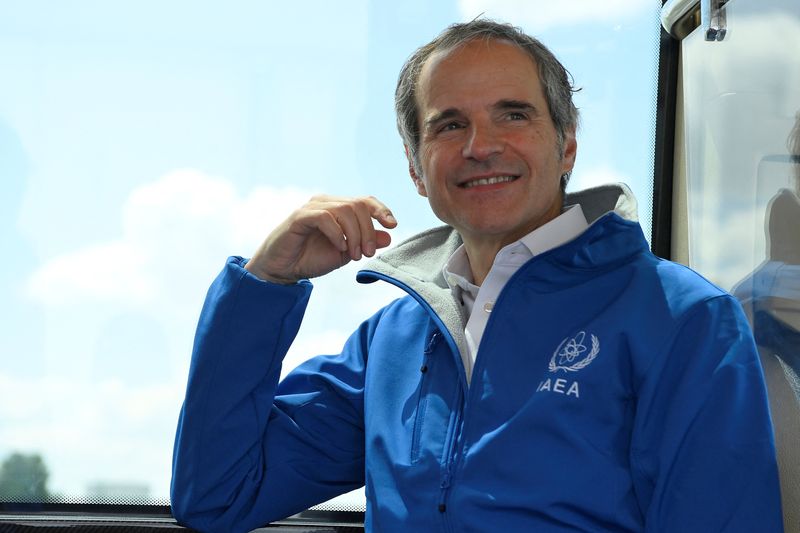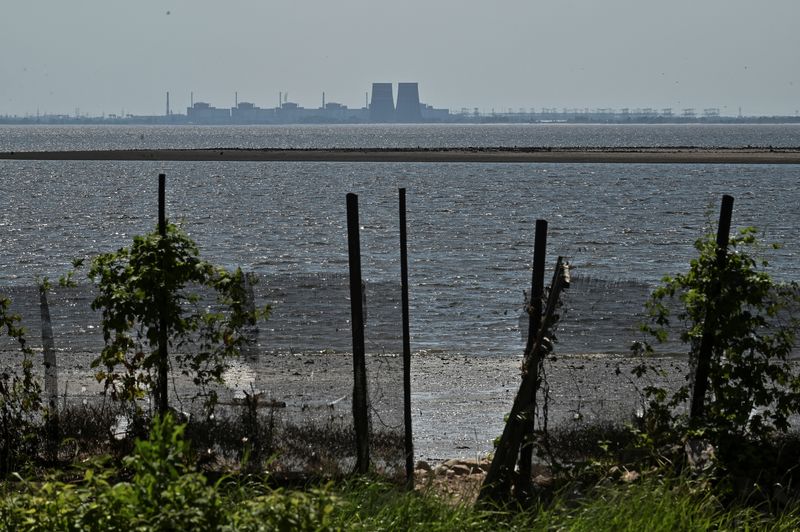By Guy Faulconbridge
MOSCOW (Reuters) - A disastrous breach in Ukraine's huge Kakhovka dam has further stoked alarm over the safety of the nearby Russian-controlled Zaporizhzhia nuclear power plant, which has for months been a target of shelling due to its proximity to military front lines.
The head of the United Nations' atomic watchdog, Rafael Grossi, will visit the area this week to check "a significant discrepancy" in water level data at the reservoir, used to fill a pond for cooling the reactors at the nuclear plant.
The International Atomic Energy Agency (IAEA) has long warned of the risks of a disaster at Zaporizhzhia, Europe's largest nuclear plant, and urged an end to fighting in the area. The plant is just 500 km (300 miles) from the site of the world's worst nuclear accident, the 1986 Chornobyl disaster.
What nuclear material is at the Zaporizhzhia plant, what are the risks and why are Russia and Ukraine fighting over it?
WHAT IS IT?
The Zaporizhzhia nuclear power plant has six Soviet-designed VVER-1000 V-320 water-cooled and water-moderated reactors containing Uranium 235, which has a half-life of more than 700 million years.
Five of the reactors are now in cold shutdown. This means a reactor's temperature is below boiling point but electrical pumps moving water through the reactor core must still keep working to cool the fuel.
One remains in hot shutdown, where regular levels of coolant are still required and the fuel remains reasonably hot as it continues to react.
WHAT ARE THE RISKS?
Russian forces took control of the plant in early March 2022, weeks after invading Ukraine. Special Russian military units guard the facility and a unit of Russia's state nuclear company, Rosatom, runs the plant.
The biggest nuclear risk is from overheating nuclear fuel, which could happen if the power that drives the cooling systems is cut or if there is not enough water to supply the cooling systems.
Russia and Ukraine blame each for shelling the facility. This has repeatedly cut power lines. There are diesel generators at the plant, which also has alternative water sources.
COOLING POND
The Zaporizhzhia nuclear plant uses a cooling pond to keep its six reactors cool. The reservoir at Kakhovka, which has lost nearly three-quarters of its water since the June 6 breach of the dam, feeds the cooling pond, which in turn brings water to the reactors and to additional cooling ponds for the spent fuel.
Ukraine said on June 12 the plant's cooling ponds remain stable and high enough.
Ukraine and Russia have accused each other of blowing up the dam.
WATER LEVELS
The breach caused a fall in water levels at the reservoir to 11.19 metres, according to Rosatom. That is down from 17 metres before the dam breach, the IAEA said.
The plant has said it can pump water from the reservoir until it falls below 11 metres, and possibly even lower, according to the IAEA.
The level of the main cooling pond is 16.65 metres, Rosatom has said. The cooling ponds have a closed loop which allows them to keep water levels replenished. Rosatom says there are several other water sources besides the reservoir.
The fear is that water levels at the Kakhovka reservoir fall so far as to make the pumps to the main cooling pond inoperable.
"At the current height of the reservoir... the water pumps continue to be operable," the IAEA said.
The pumps are not operating continuously as the main cooling pond is full and holds "sufficient water reserves for several months of cooling requirements", the IAEA said.
Petro Kotin, head of Energoatom, said on state television that, with all the reactors in shutdown, the water in the main cooling pond could be sufficient for years. If not, he said, there are additional wells that can bring in water.
COULD THE REACTOR MELT DOWN?
Pressurised water is used to transfer heat away from the reactors even when they are shut down, and pumped water is also used to cool down removed spent nuclear fuel from the reactors.
Without enough water, or power to pump the water, the fuel could melt down and the zirconium cladding could release hydrogen, which can explode.
WHAT HAPPENS IN A MELTDOWN?
A meltdown of the fuel could trigger a fire or explosion that could release a plume of radionuclides into the air which could then spread over a large area.
The Chornobyl accident spread Iodine-131, Caesium-134, Strontium-90 and Caesium-137 across parts of northern Ukraine, Belarus, Russia, northern and central Europe.
Nearly 8.4 million people in Belarus, Russia and Ukraine were exposed to radiation, according to the United Nations. Around 50 deaths are directly attributed to the disaster itself.
But 600,000 "liquidators", involved in fire-fighting and clean-up operations, were exposed to high doses of radiation. Hundreds of thousands were resettled.
There is mounting evidence that the health impact of the Chornobyl disaster was much more serious than initially presented at the time and in the years following the accident.
Incidence of thyroid cancer in children across swathes of Belarus, Russia and Ukraine increased after the accident. There was a much higher incidence of endocrine disorders, anaemia and respiratory diseases among children in contaminated areas.
WHAT ABOUT THE SPENT FUEL?
Besides the reactors, there is also a dry spent fuel storage facility at the site for used nuclear fuel assemblies, and spent fuel pools at each reactor site that are used to cool down the used nuclear fuel.

Without water supply to the pools, the water evaporates and the temperatures increase, risking a fire that could release a number of radioactive isotopes.
An emission of hydrogen from a spent fuel pool caused an explosion at reactor 4 in Japan's Fukushima nuclear disaster in 2011.
